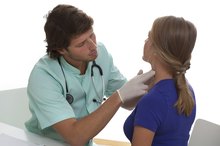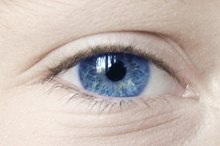Eye Problems Associated With Hypothyroidism
Hypothyroidism includes any medical condition that results in abnormally low thyroid hormone levels. Autoimmune disease, insufficient dietary iodine, surgery, inadequate stimulation of the thyroid gland and treatment for certain diseases can lead to hypothyroidism. Eye problems may develop in some people with hypothyroidism. Accurate diagnosis of the underlying cause of decreased thyroid function is an important factor in determining the appropriate therapy for eye problems associated with hypothyroidism.
If you are experiencing serious medical symptoms, seek emergency treatment immediately.
Swelling Around the Eyes
People with hypothyroidism may develop swelling around the eyes and in the face. With this condition, mucus-like proteins accumulate in the deep layers of the skin, explains the Merck Manual for Healthcare Professionals 14. With treatment of hypothyroidism, the proteins usually dissipate and the swelling around the eyes resolves.
Drooping Eyelids
Drugs & Foods to Avoid for Hypothyroidism
Learn More
Drooping eyelids, or ptosis, commonly occurs in people with hypothyroidism, notes the medical reference text "Harrison’s Principles of Internal Medicine." The level of thyroid hormones in the body influences nervous system control of the eyelid position. Decreased nerve stimulation of the eyelids associated with hypothyroidism leads to eyelid drooping. Severe ptosis may partially obstruct the field of vision.
- Drooping eyelids, or ptosis, commonly occurs in people with hypothyroidism, notes the medical reference text "Harrison’s Principles of Internal Medicine."
- Decreased nerve stimulation of the eyelids associated with hypothyroidism leads to eyelid drooping.
Exophthalmos and Eye Dryness
Thyroid eye disease most commonly occurs with a form of overactive thyroid disease known as Graves' disease. Thyroid eye disease, however, can also occur among people with hypothyroidism, notes the University of Michigan Kellogg Eye Center 3. The condition develops when antithyroid antibodies produced by the immune system also attack the soft tissues and muscles of the eye.
Exophthalmos, or bulging eyes, is a hallmark feature of thyroid eye disease. Inflammation associated with the autoimmune attack on the tissues of the eye socket cause swelling, which pushes the eyeballs forward. With pronounced exophthalmos, the eyelids may not close completely, leaving the eyes vulnerable to drying. Eye dryness typically causes irritation and a gritty sensation in the eyes.
In severe cases, thyroid eye disease and the associated dryness can lead to the development of ulcers on the eye surface, reports the University of Iowa Department of Ophthalmology & Visual Sciences 3. Scarring of the cornea--the clear area at the front of the eye--caused by surface ulcers may lead to permanent vision loss.
- Thyroid eye disease most commonly occurs with a form of overactive thyroid disease known as Graves' disease.
- With pronounced exophthalmos, the eyelids may not close completely, leaving the eyes vulnerable to drying.
Eye Nerve Damage
What Are the Causes of Film on Eye?
Learn More
Swelling of the soft tissues of the eye socket caused by thyroid eye disease can encroach on the eye nerve, also known as the optic nerve. This nerve serves as the communication circuit between the eye and the brain. Compression of the optic nerve can cause permanent damage, potentially leading to complete vision loss in the affected eye. The University of Iowa Department of Ophthalmology & Visual Sciences reports that approximately 5 percent of people with thyroid eye disease develop optic nerve problems 3. Intensive medical treatment can help reduce the risk for permanent optic nerve damage caused by thyroid eye disease.
- Swelling of the soft tissues of the eye socket caused by thyroid eye disease can encroach on the eye nerve, also known as the optic nerve.
Related Articles
References
- Merck Manual for Healthcare Professionals: Hypothyroidism (Myxedema)
- "Harrison’s Principles of Internal Medicine, 16th Edition"; Dennis L. Kasper, M.D., et al., Editors; 2004
- University of Michigan Kellogg Eye Center: Graves' eye disease
- Merck Manual for Healthcare Professionals: Eyelid Swelling
- InformedHealth.org. Underactive thyroid: Overview. Updated August 10, 2017.
- Segni M. Disorders of the Thyroid Gland in Infancy, Childhood and Adolescence. In: Feingold KR, Anawalt B, Boyce A, et al., editors. Endotext. Updated March 18, 2017.
- Almandoz JP, Gharib H. Hypothyroidism: etiology, diagnosis, and management. Med Clin North Am. 2012;96(2):203-21. doi:10.1016/j.mcna.2012.01.005
- Biondi B, Wartofsky L. Combination treatment with T4 and T3: toward personalized replacement therapy in hypothyroidism?. J Clin Endocrinol Metab. 2012;97(7):2256-71. doi:10.1210/jc.2011-3399
- Hennessey JV, Espaillat R. Current evidence for the treatment of hypothyroidism with levothyroxine/levotriiodothyronine combination therapy versus levothyroxine monotherapy. Int J Clin Pract. 2018;72(2):e13062. doi:10.1111/ijcp.13062
- Jonklaas J, Bianco AC, Bauer AJ, et al. Guidelines for the treatment of hypothyroidism: prepared by the american thyroid association task force on thyroid hormone replacement. Thyroid. 2014;24(12):1670–1751. doi:10.1089/thy.2014.0028
- Garber J et. al. Clinical Practice Guidelines for Hypothyroidism in Adults: Cosponsored by the American Association of Clinical Endocrinologists and the American Thyroid Association. Endocr Pract. 2012 Nov-Dec;18(6):988-1028.
- American Thyroid Association. (n.d.). Hypothyroidism (Underactive).
- Braverman, L, Cooper D. Werner & Ingbar's The Thyroid, 10th Edition. WLL/Wolters Kluwer; 2012.
- Surks MI. (2017). Clinical manifestations of hypothyroidism. Ross DS, ed. UpToDate. Waltham, MA: UpToDate Inc.
- Sworczak K, Wisniewski P. The role of vitamins in the prevention and treatment of thyroid disorders. Endokrynol Pol. 2011;62(4):340-44.
Writer Bio
Dr. Tina M. St. John owns and operates a health communications and consulting firm. She is also an accomplished medical writer and editor, and was formerly a senior medical officer with the U.S. Centers for Disease Control and Prevention. St. John holds an M.D. from Emory University School of Medicine.









